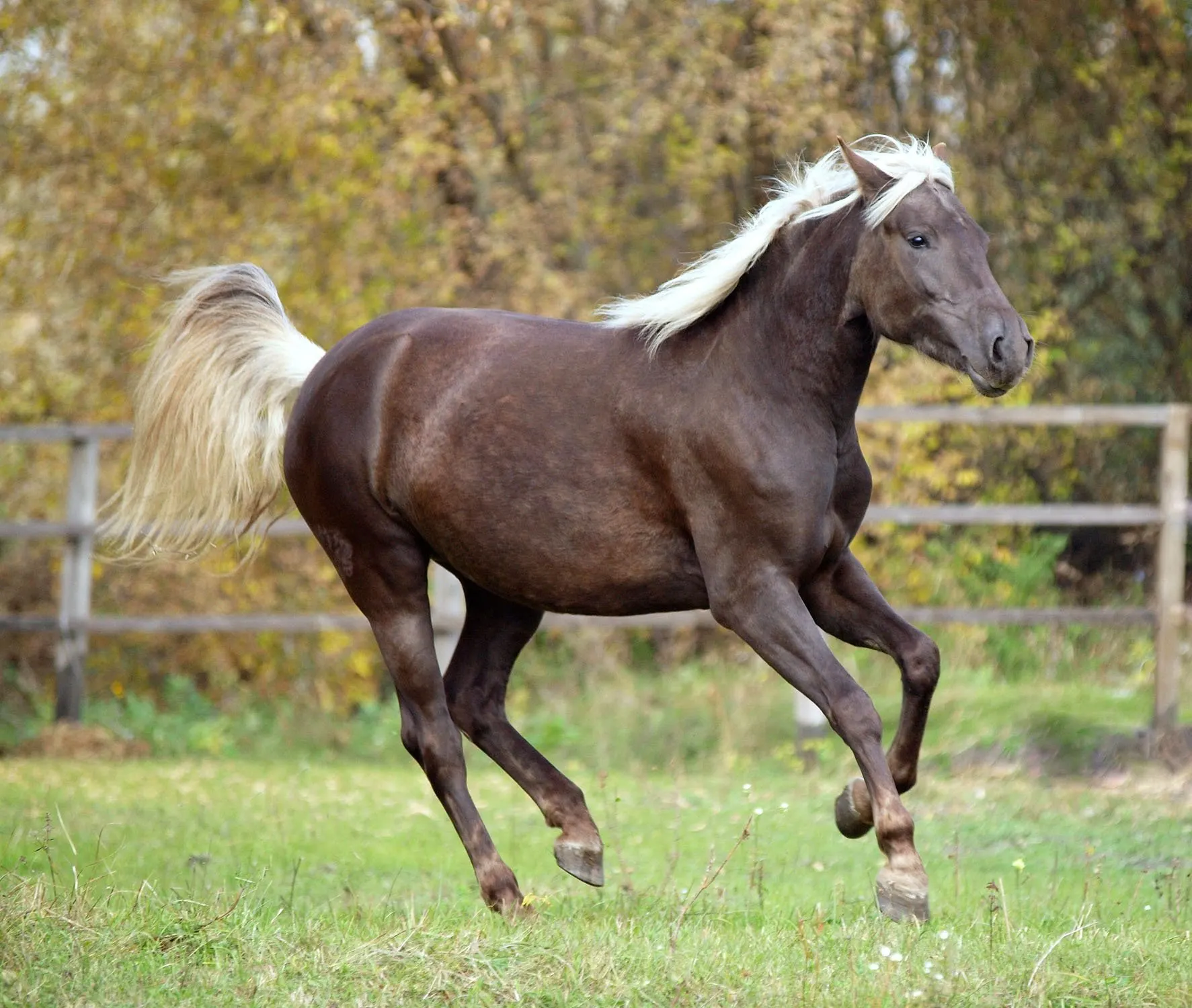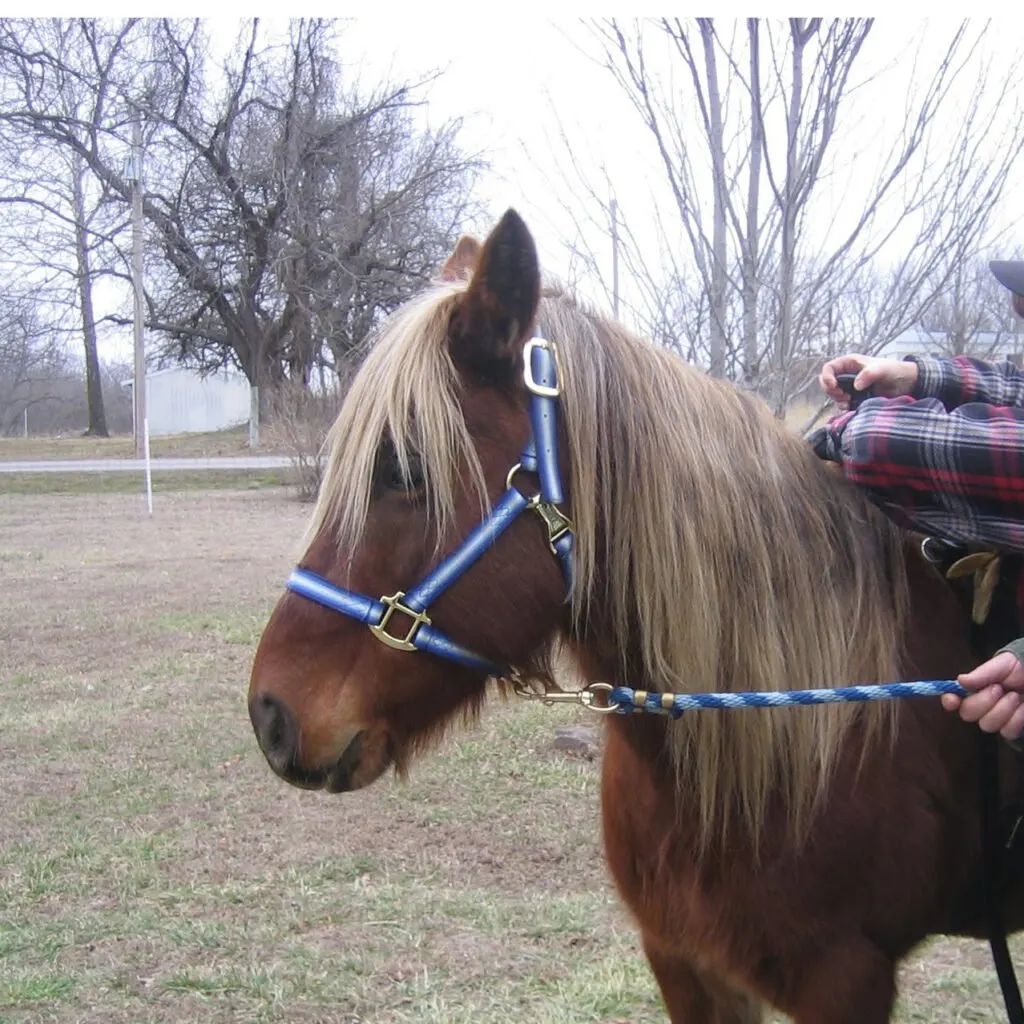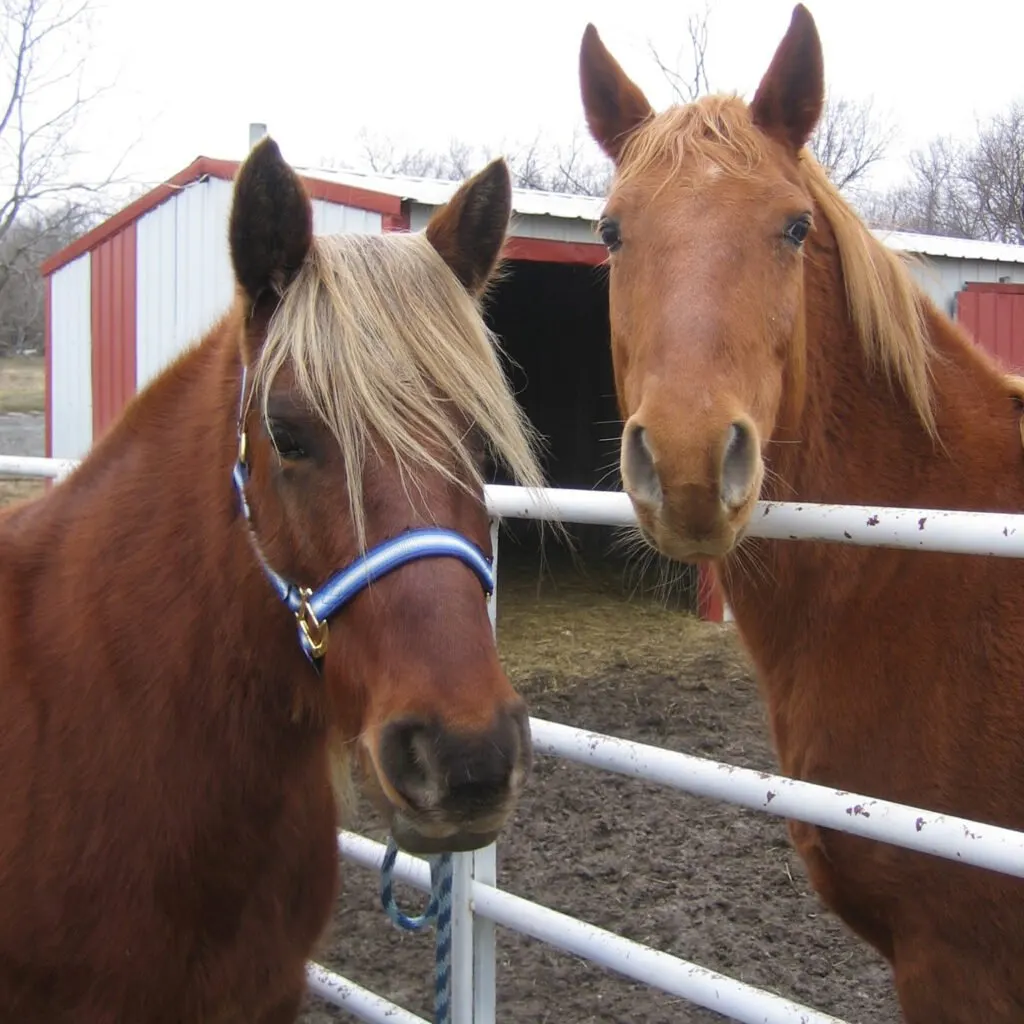A chocolate palomino horse is a horse with rich brown fur and a bright flaxen mane and tail. The way this color appears can vary between individual horses, but typically the coat is a chocolatey-brown shade, while the mane and tail range from bright white to blond.
Chocolate palomino horses are highly sought after for their head-turning appearance and rarity, and because of this sometimes suffer from hedonistic pricing.

Chocolate Palominos are Rare
Chocolate Palominos are rare- occurring in only a few horse breeds. However, they are not the rarest form of palomino horse. Even rarer, a fawn palomino results when a horse with a cremello gene also has a taffy dun gene.
Horse Breeds where Chocolate Palomino color occurs
Because horse colors can carry recessively through generations, it’s possible for unexpected colors to occur. However, Chocolate Palomino is extremely rare in most horse breeds. In a free breed registries, however, it occurs more regularly. Here are a few breeds where this color occurs most frequently.
- Quarter Horse: As the most popular horse in America, it’s no wonder the most common horse breed also features this desirable color. Quarter Horses are most popular among western riding enthusiasts and are often used for rodeo, trail, and western pleasure riding.
- American Saddlebred: This breed is known for its high-stepping gaits and refined appearance- plus, they’re one of the oldest true American horse breeds. Thanks to outcrossing with mustang stock in the late 19th century, some American Saddlebreds carry genes to produce chocolate palomino foals.
- Tennessee Walking Horse: This breed is known for its smooth, ground-covering gait and gentle disposition. Although the color is not common, some Tennessee Walking Horses have the potential to produce chocolate palomino offspring.
- Rocky Mountain Horse: Stocky, gaited, and boasting a gentle disposition, this breed (related to the two breeds above) is the breed in which Chocolate Palomino coloring occurs most frequently.
Did you notice a theme in that list? Chocolate palominos are much more common in gaited breeds. (A gaited horse is a horse that moves in a “shuffle” or “gait” instead of the walk, trot, and canter you’ve seen in movies.)


Genetic Makeup
A Chocolate Palomino results when a horse has genes for both chocolate brown and palomino. More specifically, a horse must carry a chestnut base coat (ee) and a copy of the cream dilution gene (nCr) to be a “true” chocolate palomino.
A Taffy by another name…
Horse color genetics are confusing. They’re made even harder to understand because different breed organizations refer to colors and color-genes by different names. “The Chocolate gene, so sought after in the Rocky Mountain Horse breed, is often known by the name Silver Dapple or Taffy in other breeds.”1 If you’re interested in understanding horse color genetics, learning the names that scientists use for genes can help you read between the lines of horse classified ads and internet forums.
Identifying a Chocolate Palomino
Look out, there are some look-a-likes! Some common horse colors look like chocolate palominos in the right light. A common color confused with this rare one is sorrel (brown) horses with especially dark body fur and light manes and tails.
Determining if a horse is a chocolate palomino isn’t as simple as it might sound. A DNA test to learn a horse’s genetic color might be the only way to know for sure. Horse owners can do a DNA test through the UC Davis Veterinary Genetics Lab to find out exactly what color genes their horse carries.
But it’s not just genes: According to veterinary researcher Muhammad Abubakar, a horse’s color isn’t just based on genes, but also varies by the horse’s age, time of year, exposure to the sun, and nutritional status.2 The classic example of environmental color change is the commonly seen black horse with coat bleached by the sun to look brown.
Other Brown Horses with White Manes
Brown horses with white manes, similar to a genetic chocolate palomino, can sometimes be created through other arrangements of horse color genes. Dark brown horses with white manes have been seen in horses who were genetically liver chestnut, silver dapple black (black with a silver gene), and sooty palomino (red with a cream gene and a sooty gene).
Brown horses with white manes are often identified as chocolate palomino, but if the brown is copper or red-tinted, it’s probably not a chocolate palomino. “in contrast to the solid color sorrels, the palomino had a deep golden, dappled coat and a solid white mane and tail”3
Here’s an example photo of a brown horse with a light mane and tail that is actually sorrel, not palomino:
While horses don’t change genetics as they are, sometimes, golden palomino horses can darken to a chocolate Palomino as they age, this was the case with one notable stallion, Creme de Coca, described in the Palomino horse registry in 1949.4
Chocolate Palomino Prices
In an informal study of horse classified ads on 2 leading horse classified sites in March of 2023, our team determined that when other variables were equal, chocolate palominos were priced 15-25% higher. This is likely because, according to researchers at Kansas State University, people are willing to pay for a highly desirable horse, even if the horse isn’t objectively worth the price.5
The cost to buy a chocolate palomino horse ranges from around $4,000 USD for a foal up to $10,000 to buy a fully trained riding horse.
Take a quiz to learn if you’re ready for your first horse.
Historical Facts
- Interestingly, Chocolate Palomino is one of the “youngest” horse colors. Researchers believe that dilute colors like palomino didn’t appear in horses until after they were domesticated- roughly 3000 BP, during the Bronze Age.6
How can you get a chocolate palomino horse?
The easiest way to get a chocolate palomino is by purchasing one from a trusted source. It is also possible to breed for the combination of genes that produce this color, however the color of a foal is never guaranteed! To get a chocolate palomino-colored horse by breeding, you’ll need to find a mare and a stallion with genes for both a brown coat and a cream-colored coat. If they have a foal together, it might be a chocolate palomino.
What is the name of a brown horse with a light mane?
The name of a brown horse with a white or flaxen mane and tail is Chocolate Palomino. This color combination is only possible in a few breeds, because of the unique genetics involved.
- Wild Mountain Farms. Frenchtown, MT. Cached on Internet Archive [↩]
- Trends and Advances in Veterinary Genetics. (2017). Croatia: IntechOpen. [↩]
- Bramblett, B. J. (2005). Flying Change. United States: iUniverse. describing a chocolate palomino. [↩]
- Norton, D. M. (1949). The Palomino Horse. United States: Borden Publishing Company. [↩]
- Freeborn, J. (2009). Hedonic price analysis of the internet recreational equine market (Doctoral dissertation, Kansas State University). [↩]
- Trends and Advances in Veterinary Genetics. (2017). Croatia: IntechOpen. [↩]


